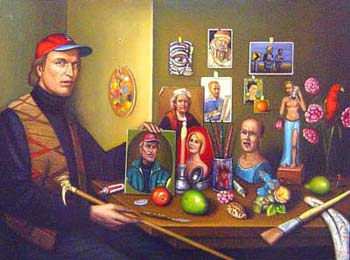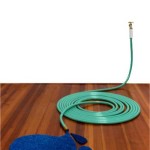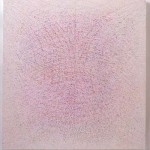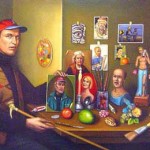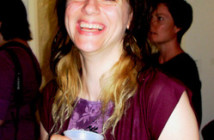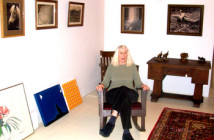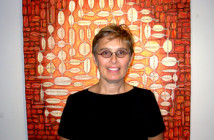Randall Deihl: An American Realist
R. Michelson Galleries
132 Main Street, Northampton, MA
Through May 20
When the 19th century artist Gustave Courbet was asked why he did not paint angels like others in the annual Salon exhibitions, he famously answered, “Show me an angel and I will paint an angel.” By the standards of the time his works depicted subjects which, while occasionally erotic and provocative, were numbingly ordinary. He represented what he could see and had meaning in the everyday world around him. This notion came to be known as Realism. A term today so abused that, with some exceptions, is devoid of meaning. It is used to describe virtually any form of representational work, with such readily identifiable exceptions as Pop and Surrealism, as essentially not “abstract.” The umbrella of “realism” may shade and shelter artists as diverse as Alex Katz, Eric Fischl, Richard Estes, Jack Beal, Damien Hirst, Cecily Brown, Damian Loeb, Lisa Yuskavage, Rackstraw Downes, and Thomas Kincaid.
The remarkably dense, diverse, raucous, scabrous, gonzo paintings by the Pioneer Valley Realists, are... well, anything but. Real. Not really. Much more than that. Deihl has been linked with several peers and colleagues including the now deceased, by then divorced artists, Gregory Gillespie and Frances Cohen Gillespie, as well as Scott Prior and Jane Lund. They epically became fixed together when Deihl created a remarkable group portrait of his peers in a studio setting that recalls the 19th century French painter, Fantin Latour. That seminal painting was acquired for the Museum of Fine Arts Boston by the former curator of American Painting, Theodore E. Stebbins, Jr. who is now an adjunct curator at the Fogg Art Museum. Sad to say, I have never seen that work displayed at the MFA, and will not hold my breath during the tenure of Cheryl Brutvan.
Of the important Northampton group, or Valley Realists, the paintings by Frances Gillespie adhered most closely to the term. Unlike the others, she stuck to what she saw. Slavishly. As I found out in 1988 when I organized a traveling exhibition “Here’s Looking at You: Contemporary New England Portraits.” The exhibition included the entire group with the exception, to my regret, of Gregory. But it was not intended to focus on the Valley Realists and featured several other artists including James Aponovich who is the subject of a major exhibition now on view through June at the Currier Museum of Art in Nashua, New Hampshire.
As we were approaching deadline for the catalogue of that show, there were frantic weekly calls from Frances. In halting tones, with breathy gasps, she would ask if it was too late to send a new photograph of the slightly-under-life-sized painting of a robed woman with bare feet seated next to a clearstory window. The painting was started a couple of years earlier in Italy and would be in process for a couple of years after the traveling exhibition. To my eye there was no discernable difference in the series of photos that she sent to me by Fed Ex over a span of several weeks. But to Fran there was an epic difference. I guess you could call that, as the 19th century British critic John Ruskin would have it, “Truth to Nature.”
Yes, there are works in the Michelson show that might be loosely called realism. But what is so compelling and fabulous about the work is the artist’s willingness to supe-up color and intensify his already quirky, jazz subjects. He has his hand on the jugular of an American Vernacular. This is narrative genre at its best. Every picture tells a story but Deihl is a novelist.
If “less is more” is a coda of the avant-garde then the mantra of Deihl is “more is more.” So that would identify him as a counter revolutionary or an anathematic modernist. His campy paintings are lovable basset hounds in a fashionable art world of primped poodles. With an Eye on America he has scoured for rural sites. Randall and his artist wife, Nancy Hill, lived and worked for several years in the South West before returning to New England. He was always on the lookout for the homely and homey. To record like a rural anthropologist a Mom and Pop world of funky diners and shops, with their hand made signs, that are becoming obsolete through the blight of the malling of America.
He conveys an uncanny beauty and serenity in “Nick’s Nest in Winter” a depiction of a generic, gray building abutting a highway with signs for Bus Service and gas pumps. There is snow in the foreground as well as capping the mountains seen over the roof of the large structure. There are subtle in jokes as he often includes his friends in images such as “Nick’s Nest at Night” staring out of windows. During frequent photographic sessions the artist Scott Prior told me that “I am often posed with a hotdog stuck in my mouth.” There are a couple of cops swinging nightsticks in front of the outdoor food stand in “Seafood Cops.” The Miss Florence diner inside and out appears to be a favorite site, as is Fenway Park home of the Boston Red Sox. A true fan, Deihl hopes to make a series of paintings with the endorsement of the team. There are a number of bucolic views of the farm country of Western Massachusetts including a gem “Three Graces” which depicts old trucks abandoned in a field.
In addition to the landscapes he creates complex still-life paintings that, in their formal arrangements and disparate objects, recall aspects of works by Gregory. When you look at the works of the group, a long overdue project for a major museum exhibition, there are many confluences. Randall hints at squabbles over who had rights to certain sites and subjects. This is further complicated by the fact that he and Prior often hunt together. So who has dibs on those fairground and carnival themes that show up in their works? A key difference is that Prior’s works tend to be more concerned with traditional luminism where Deihl pushes for saturated chroma and vibrant narratives. He is the gonzo update of the traditional rural scenes of Currier & Ives.
There are also the portraits to contend with. As I discovered back in 1988, they have produced numerous self-portraits as well as affectionate depictions of each other. In that show Lund provided a small, intense, surreal image of Gregory, bare chested as he often depicted himself, at the easel surrounded by the clutter of his studio. It was a masterpiece. Remarkably, among the Valley Realists, there are few (if any) commissioned portraits. They exclusively painted themselves, family, and friends.
The selection of self portraits in this exhibition reveals far more than what the artist looks like. There are fake tattoos on bare chests that reference a range of homages and influences to the Old Masters from Durer, Caravaggio, Velasquez, van Gogh and Rembrandt to, James Ensor, Frida Kahlo and Otto Dix. There is a stunning pair of large portraits of the artist and his wife in Indian garb. Randall’s self portrait is an uncanny reference to the great 19th century Indian painter George Catlin. But the gem, the absolute masterpiece in this show is from the ongoing series of “Palette Portraits.” In these the artist sands down used palettes which come to him through a variety of sources. Then he creates an homage. In this show there is a poignant image of Gregory displayed on an elaborately adorned and decorated easel. He acquired the palette from the artist’s widow, Peggy, during a visit to the studio. Greg is shown hunched over horizontally, seeming to crouch to fit into the confines of the palette. He is shown at work, that same palette in hand. It is a stunning and poignant tribute. They had planned to meet with friends and the collector Arthur Goldberg (who has also discussed this with me) for lunch that fateful day. It never happened. This wonderful “palette” portrait gives testament to a remarkable relationship in an incredible circle of friends.
Masako Kamiya: New Paintings
Gallery Naga
67 Newbury Street
Through April 23
It has taken roughly a year and a half for Masako Kamiya to create the six, 32 x 30” panel paintings for the current exhibition at Gallery Naga. They are simply miraculous. Although fortunate to acquire a smaller, earlier piece I found myself salivating over this selection of eagerly anticipated new works. Unfortunately, this week instead I will be writing a check to the IRS roughly equivalent to the cost of purchasing one of these simply stunning works. My crystal ball tells me I am making a terrible mistake.
We don’t just look at these paintings, no, our eyes devour the rich encrusted surfaces with their swaying fauna of small, raised dots of undulating color. They are tiny psychedelic fields of mushrooms sprouting after an acid rain of dreams. The pieces with the subtle mantras of individual colors invite tantric meditations. This must be the trance-like state that the artist evokes in order to patiently produce these meticulous, labor intensive works. Considering the ridiculously modest prices that they sell for the artist can scarsely be earning minimum wage. Gallery Naga should be reported to the department of labor.
In some of the pieces there is an implied under-drawing. One may discern a flow of direction and pattern rather like Heisenberg’s predictions of the Uncertainty Principle as particles mysteriously appear and disappear in a cloud chamber. It would be a Solomon’s decision to select a best or favorite piece. Personally I like the "yellow/green" one. But the “purple” is equally seductive and the “white” is oh so subtle. These are pieces in the pointillist tradition of Seurat, but non-representational. I truly envy those individuals who will get to view them every day for the rest of their lives. They are so profoundly calming. The visual equivalent of a soothing cup of green tea.
Brian Zink: New Work
Howard Yezerski Gallery
14 Newbury Street
Through April 19
The “paintings” of Brian Zink, currently on view in the project space of Howard Yezerski Gallery, have always involved the use of exotic materials. In the past he assembled patterns of bright colored plexi with applied graphic elements. They were lively and attractive pieces. The new series is comprised of somewhat larger, stronger, more minimalist graphic works. They are industrial strength stripe paintings. The source of influence is Neo Geo. But I find the growth in the work ambitious and compelling. So much so that I did not immediately identify this as work by Zink. Its use of opaque, colored, two tone, plastic bands, curved at the edges and projecting nicely from the wall was that much of a developmental departure. I sense that the artist will do well with hip curators and adventurous collectors. The work is fresh, clean and zinky.
Lorey Bonante: A Bee in Her Bonnet
Margaret Swan: Vital Spirit
Boston Sculptors Gallery
486 Harrison Avenue
Through April 16
The large space of Boston Sculptors Gallery in the South End has been divided into two one-person exhibitions. In the front "Vital Spirit" features works in copper, including several large, free standing pieces as well as a series of reliefs by a veteran, Margaret Swan. The other area houses the first one-person exhibition with this artist-run organization by Lorey Bonante, a diverse and eclectic show titled “A Bee in Her Bonnet.” The works on view couldn’t be more different in material and sensibility but they seem comfortable with each other.
This selection of new sculpture by Swan was both familiar and not. Some of the relief pieces evoke her long commitment to the escutcheon theme. These are shapes that reference the heraldic tradition, knights of some long ago Round Table now just signifiers of shape and memory. But there are also departures that explore other forms and groupings that suggest triptychs. There are several free standing pieces that recall cypress trees. There is a clustering of vertical elements that reference nature. But abstractly, with an emphasis on the working of the material and its patina. The raw bright copper has been muted and stained. Overall, there may be a bit too much work on view. The visual impact and appreciation of individual pieces might have been enhanced by an edit. By overexposure some of the work seems redundant.
There is also a lot of work on view by Bonante. But because of its mostly intimate scale and rich variety of material, subject and form this proves to be less distracting. There is a cluster of small relief pieces attached to the wall on one side of the space and this is bracketed by a row of works on shelves on the other side. In the intervening space is a combination of free standing and suspended pieces. The unifying notion is that all of the works involve dipping in wax and a consistent approach of recycling interesting and nostalgic found objects. The artist has a penchant for making eyeballs by dipping Styrofoam balls and attaching to them doll eyes. These get used in a variety of approaches. In one instance a pair of old high heel shoes have been stripped down, dipped and then a cluster of eyes look up from their soles/souls. In a hanging piece, an old dipped female undergarment of some kind, the eyeballs in a clustered ring, are attached as a strange accessory. Other pieces involve circles of ribbon which have been pulled out into bestial horns, tiny little rhinos or other mythic creatures. Each piece demands separate attention and thinking, like a small chair with a lyre back that suggests music. Its seat is adorned with hammers appropriated from a deconstructed piano, but not for sitting. Or the long suspended stockings that imply tall, skinny abandoned legs. The Pippy Long Stockings of memory. Overall, a stunning debut.
Magda Fernandez: Home Sweet Gated Home
Allston Skirt Gallery
450 Harrison Avenue
Through April 30
This is a bright, insightful, witty exhibition of slick laminated wall pieces by the Cuban born artist, Magda Fernandez. The gallery is augmented with such catchy items as a folding lawn chair, garden hose, with some blue plastic “water” as well as a daunting shelf of pesticides, with the protective rubber gloves and gear to handle them, straight from Home Depot. Or should one more correctly say the Department of Homeland Security Depot.
The artist implies something sinister and amok behind the sealed off high security protection of the ersatz Gated Communities which are the subject of this over the top send up. She sees threats where none exist. It is an update of the classic Poe story “The Mask of the Red Death” or “The Decameron” by Boccaccio, where individuals try to lock out the Plague only to find that it has penetrated their fortress. What has been locked out may also be locked in. What madness the artist implies. The smart and graphic images are derived by the use of appropriations through Photoshop as well as elements created using Illustrator computer programs. These resultant one-of-a-kind images have been printed and laminated. The presentation is slick and frameless. While visually attractive I am not sure I grasp all of the rich implications of the work. Or why she feels so compelled to comment on those who want to lead such sheltered lives.
Sharon Shapiro: It’s Not the Heat, It’s the Humidity
OSP Gallery
450 Harrison Avenue
Through April 16
This relatively small gallery space in what is the larger back office of Open Studio Press initially featured artists selected from juried editions of New American Painting which is published six times a year on a rotating regional basis. But Steve Zevitas, its publisher, has gradually evolved away from that restriction to simply work with artists that interest him.
A strong case for this approach is the current exhibition that features a series of small figurative drawings and watercolors by Sharon Shapiro, an artist based in Charlottesville, Virginia. She was going through a kind of crisis in the work when, at the suggestion of Zevitas, she veered off on an experiment to make a hundred drawings in a hundred days. During a visit to the gallery he pointed to the first in the series, an image of the very pregnant artist depicting her marvelously fecund belly. It is a moving and tender image. From that she evolved into a series of fragments and body parts referencing herself and women friends. These developed from minimalist black and white drawings to quick and washy water colors. They seem spontaneous and inattentive to detail. Almost primitive and naive but more than likely deliberate and knowing. That is the look of a lot of contemporary work that explores the edge between the finished and serendipitous. The artist in this case is more grown up and sophisticated to turn out such kiddy work. The images, however, are engaging and smart in a nice way. I can see why Steve likes them. There is a ton of this kind of work out there as was brought home during the recent Scope Fair and Greater New York exhibition at PS1. There is a heck of a lot of kid stuff going on.
Other brief SOWA notes and comments.
I need to go back and spend more time with the new work by a contemporary master, Abelardo Morell, the Cuban born photographer at Bernard Toale Gallery. He appears to have moved on from his signature pinhole series. Here is presenting large format, black and white prints of objects such as chemistry lab glass wares. Similarly, I didn’t spend enough time and am not sure I understand the elaborate setups for color photographs by Thomas Gustainis at Gallery Kayafas. But it seems that I had more than enough time not to appreciate the three artists, Pablo Vargas Lugo, Nicole Cherubini, and Lamar Peterson at Samson Projects. Nice try, but for now, thanks but no thanks. Don’t bother to ask me why. Just a gutless feeling.
- Magda Fernandez, Home Sweet Gated Home, garden hose and astro-turf.
- Masako Kamiya, Blushing Season, gouache on panel, 2004/5.
- Randall Deihl, Double Self-Portrait, Oil on Canvas.
Links:
R. Michelson Galleries
Gallery Naga
Howard Yezerski Gallery
Boston Sculptors Gallery
Allston Skirt Gallery
OSP Gallery
Bernard Toale Gallery
Gallery Kayafas
Samson Projects
All images are courtesy of the artists and the respective venue.

